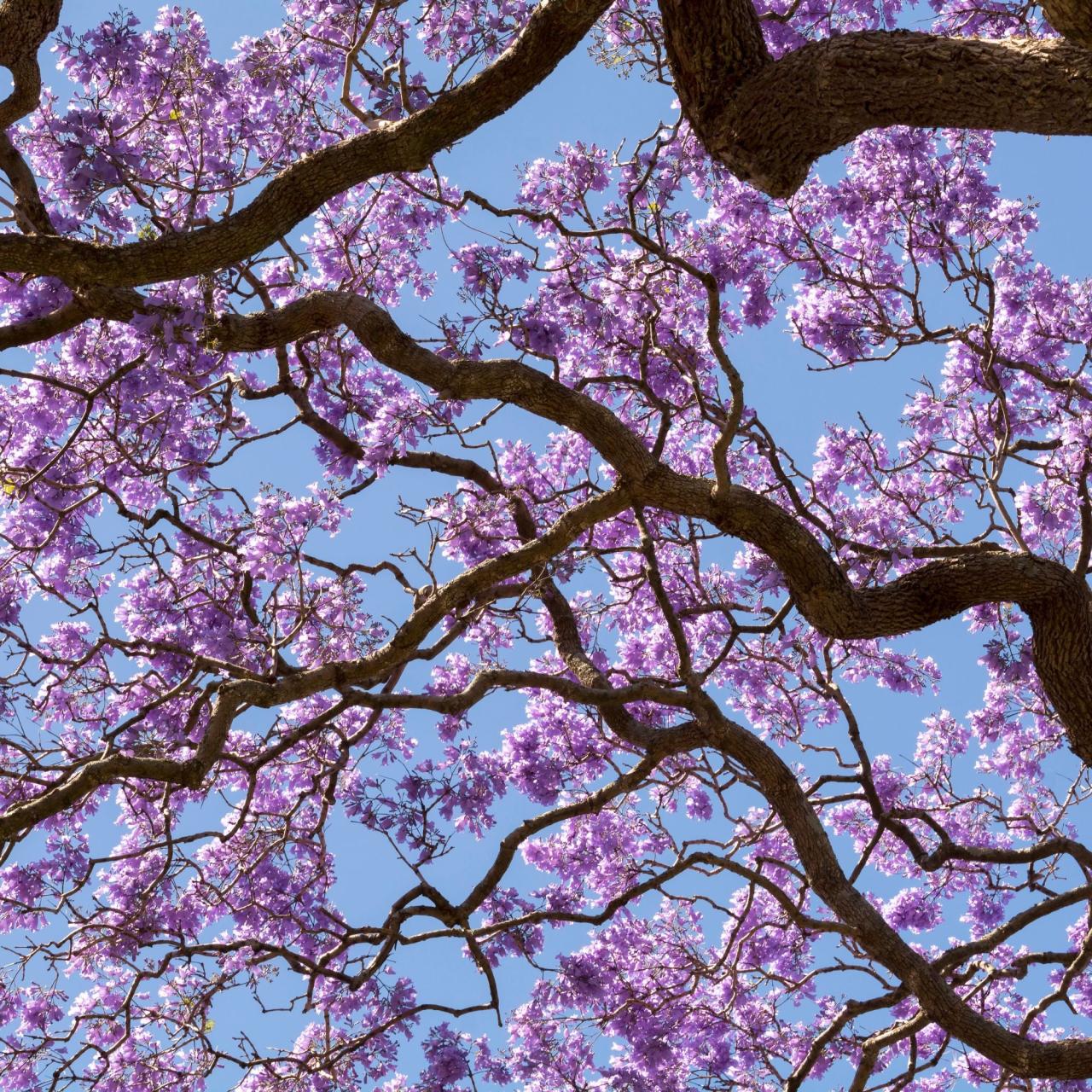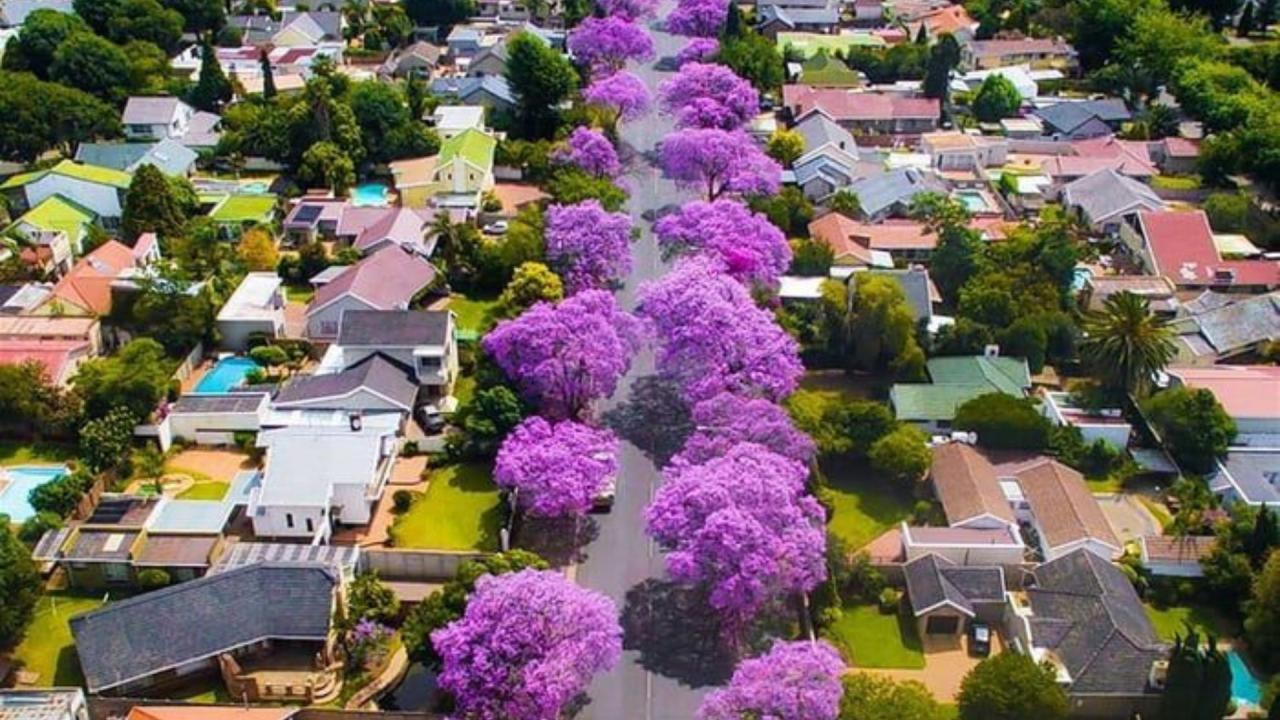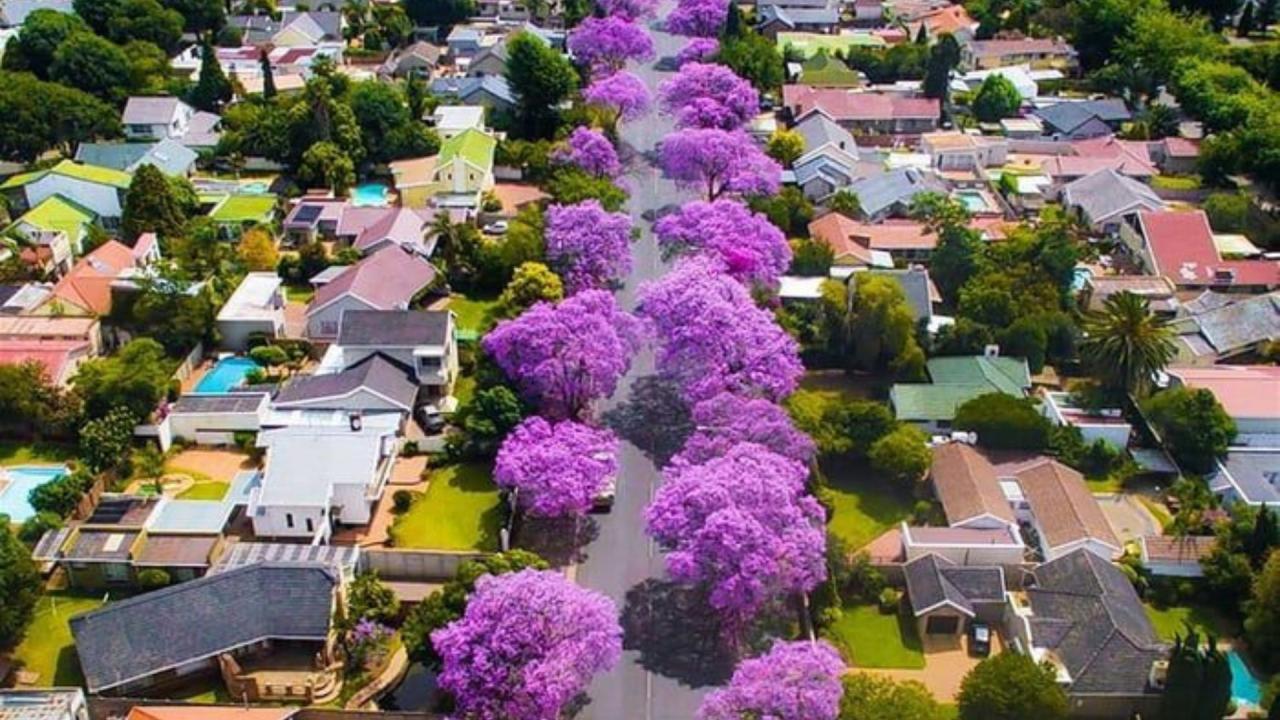Jacaranda Tree Magic: How to Create a Gorgeous and Colorful Garden Feature, transports you to a world of vibrant blooms and captivating landscapes. The Jacaranda tree, with its mesmerizing lilac flowers, is more than just a plant; it’s a symbol of beauty, joy, and a touch of magic.
Its cascading blossoms paint the landscape with a breathtaking spectacle, transforming ordinary gardens into enchanting havens.
From its unique characteristics and cultural significance to the art of planning and maintaining a Jacaranda garden, this guide explores every facet of this extraordinary tree, empowering you to create your own piece of Jacaranda magic.
The Allure of the Jacaranda Tree
The Jacaranda tree, with its vibrant purple blooms and elegant, fern-like foliage, is a captivating sight that transforms landscapes into ethereal realms of color. Its beauty and cultural significance have made it a beloved garden feature across the globe, bringing a touch of magic to urban streets and rural gardens alike.
The Jacaranda Tree’s Unique Characteristics
The Jacaranda tree’s allure stems from its striking visual appeal. Its delicate, bell-shaped flowers, clustered in large panicles, burst forth in a symphony of purple, creating a breathtaking spectacle. The flowers are typically a vibrant shade of violet-blue, but can also range from lavender to a deeper, almost indigo hue.
These blossoms are a striking contrast against the tree’s lush, green foliage, which is comprised of finely divided leaflets resembling those of a fern.
The Jacaranda tree, with its stunning violet blooms, can be a showstopper in any garden. For a truly magical effect, consider combining this vibrant tree with a fragrant rose garden. Learn how to propagate your own rose bushes from cuttings using the techniques outlined in Expert Rose Growing: How To Propagate Roses From Cuttings for a Stunning Garden , and you’ll have a beautiful and fragrant oasis in no time.
The contrasting colors and textures of the Jacaranda and roses will create a truly unforgettable garden experience.
Cultural Significance and Symbolism
The Jacaranda tree holds a special place in the hearts of many cultures. In South Africa, where it is widely planted, the tree is synonymous with the arrival of spring and is often associated with good luck and prosperity. The blooming season, which coincides with the start of the academic year, is affectionately referred to as the “Jacaranda season,” and students often celebrate by showering each other with fallen blossoms.
In Australia, the Jacaranda tree is deeply ingrained in the cultural fabric of the country. Its vibrant blooms are celebrated in festivals and art, and the tree has become a symbol of the country’s unique natural beauty.
The Impact of the Jacaranda Tree’s Blooming Season
The Jacaranda tree’s blooming season transforms the surrounding landscape into a vibrant, colorful tapestry. The abundance of purple blossoms creates a mesmerizing visual spectacle, turning streets, parks, and gardens into enchanting realms of color. The trees’ vibrant blooms attract pollinators, such as bees and butterflies, adding a touch of life and movement to the environment.
Planning Your Jacaranda Garden

Creating a beautiful and vibrant garden with a Jacaranda tree as its centerpiece requires careful planning and consideration of the tree’s unique needs and characteristics.
Jacaranda Growing Conditions
The Jacaranda tree thrives in warm climates with plenty of sunshine. It prefers well-drained soil that is slightly acidic to neutral. The tree can tolerate some drought conditions but prefers regular watering, especially during its establishment phase.
- Climate:Jacaranda trees are native to tropical and subtropical regions and are best suited for climates with warm temperatures and minimal frost. They can withstand light frosts but may experience damage or dieback in colder climates.
- Sunlight:Jacaranda trees require full sun, meaning at least 6 hours of direct sunlight daily. This ensures optimal growth and abundant flowering.
- Soil:Jacaranda trees prefer well-drained soil that is slightly acidic to neutral. They can tolerate a range of soil types, but poorly drained soils can lead to root rot.
Garden Layout Considerations
When designing your Jacaranda garden, consider the tree’s mature size and growth habit. Jacaranda trees can grow to heights of 40-60 feet and have a spreading canopy. This means you’ll need to choose a location that provides ample space for the tree to grow without obstruction.
- Mature Size:Jacaranda trees can reach a mature height of 40-60 feet and a canopy spread of 30-50 feet. It’s crucial to select a location that accommodates its mature size to avoid conflicts with structures or other plants.
- Growth Habit:Jacaranda trees have a spreading, vase-shaped canopy, meaning they can cast a wide shade. This can impact the placement of other plants in your garden.
- Focal Point:Position the Jacaranda tree as a focal point in your garden, allowing it to stand out and dominate the landscape. It can be a stunning centerpiece for a lawn, courtyard, or even a larger garden space.
Planting Your Jacaranda Tree
Planting a Jacaranda tree is a relatively straightforward process. Follow these steps to ensure your tree has the best chance of thriving.
- Select a Tree:Choose a healthy Jacaranda tree from a reputable nursery. Look for a tree with a strong root system and a well-developed trunk.
- Prepare the Planting Site:Select a location that meets the Jacaranda’s growing conditions. Remove any weeds or debris from the area. Dig a hole that is twice as wide and as deep as the tree’s root ball.
- Plant the Tree:Gently loosen the roots of the tree and place it in the hole, ensuring the root ball is level with the ground. Backfill the hole with the original soil, leaving a slight mound around the base of the tree.
- Water Thoroughly:Water the newly planted tree deeply, ensuring the soil is thoroughly moistened.
- Mulch:Apply a layer of mulch around the base of the tree, extending beyond the drip line. Mulch helps retain moisture, suppress weeds, and regulate soil temperature.
Watering Techniques, Jacaranda Tree Magic: How to Create a Gorgeous and Colorful Garden Feature
Jacaranda trees need regular watering, especially during their establishment phase. They are drought-tolerant but prefer consistent moisture.
- Watering Frequency:Water the tree deeply once a week during the first year after planting. Reduce watering frequency to once every two weeks after the tree is established.
- Watering Depth:Water the tree deeply, ensuring the water reaches the root zone. A slow, deep watering is better than frequent, shallow watering.
- Mulch:Mulching around the base of the tree helps retain moisture and reduces the need for frequent watering.
Enhancing Your Jacaranda Feature
Once you have your Jacaranda tree in place, you can begin to create a beautiful and harmonious garden around it. By combining complementary plants and flowers, you can create a vibrant and visually stunning landscape. The Jacaranda tree’s cascading purple blooms can be accentuated and highlighted with careful plant selection, leading to a more captivating and visually appealing garden.
Plant Combinations for a Vibrant Jacaranda Garden
To create a vibrant and harmonious garden, consider incorporating plants that complement the Jacaranda tree’s color and texture. The Jacaranda’s vibrant purple blooms can be enhanced by choosing plants with contrasting colors, such as bright yellows, oranges, and reds, or by incorporating plants with complementary colors, such as blues and purples.
The Jacaranda’s delicate foliage can also be balanced by incorporating plants with bold textures, such as succulents, ferns, or grasses.
- Bright Contrasts:
- Yellows:Golden Barrel Cactus ( Echinocactus grusonii), Yellow Bird of Paradise ( Strelitzia reginae), Golden Dewdrop ( Duranta erecta)
- Oranges:Orange Calendula ( Calendula officinalis), Mexican Bird of Paradise ( Caesalpinia pulcherrima), Orange Hibiscus ( Hibiscus rosa-sinensis)
- Reds:Red Salvia ( Salvia splendens), Red Ixora ( Ixora coccinea), Red Bougainvillea ( Bougainvillea spectabilis)
- Complementary Colors:
- Blues:Blue Salvia ( Salvia farinacea), Blue Hibiscus ( Hibiscus syriacus), Blue Agapanthus ( Agapanthus africanus)
- Purples:Purple Verbena ( Verbena bonariensis), Purple Coneflower ( Echinacea purpurea), Lavender ( Lavandula angustifolia)
- Bold Textures:
- Succulents:Agave ( Agave americana), Aloe ( Aloe vera), Echeveria ( Echeveriaspp.)
- Ferns:Boston Fern ( Nephrolepis exaltata), Lady Fern ( Athyrium filix-femina), Sword Fern ( Nephrolepis cordifolia)
- Grasses:Fountain Grass ( Pennisetum alopecuroides), Ornamental Grass ( Miscanthus sinensis), Zebra Grass ( Miscanthus sinensis‘Zebrinus’)
Designing a Jacaranda Garden
A Jacaranda garden can be designed to highlight the tree’s beauty and create a sense of tranquility. Consider the following:
- Placement:Position the Jacaranda tree as a focal point in your garden. This could be in the center of a lawn, at the end of a pathway, or near a seating area.
- Color Scheme:Choose a color scheme that complements the Jacaranda’s purple blooms. Consider using shades of purple, blue, yellow, or orange.
- Texture:Incorporate plants with different textures to add depth and visual interest. For example, you could use a combination of smooth-leaved plants, spiky plants, and feathery grasses.
- Layout:Consider the shape of your garden and the placement of other trees and plants. You can create a formal garden with straight lines and symmetrical plantings, or a more informal garden with curved pathways and a natural feel.
Incorporating Garden Elements
To enhance the aesthetic appeal of your Jacaranda garden, consider incorporating elements like pathways, seating areas, and water features. These elements can create a sense of flow, provide a place to relax and enjoy the garden, and add visual interest.
- Pathways:Wind a pathway around the Jacaranda tree, leading to a seating area or another focal point in your garden. You can use gravel, pavers, or stepping stones to create a pathway.
- Seating Areas:Create a comfortable seating area under the canopy of the Jacaranda tree. You could use a bench, chairs, or a hammock. Add cushions and pillows for extra comfort.
- Water Features:A small fountain, pond, or waterfall can add a calming element to your Jacaranda garden. The sound of water can create a sense of peace and tranquility.
Maintaining Your Jacaranda Garden: Jacaranda Tree Magic: How To Create A Gorgeous And Colorful Garden Feature

Jacaranda trees are relatively low-maintenance, but they do require some care to thrive. Regular maintenance ensures a healthy, vibrant tree that produces its stunning purple blooms year after year.
While Jacaranda trees are renowned for their stunning purple blooms, creating a captivating garden experience goes beyond just planting. Adding a touch of autumnal charm, even in the midst of vibrant blooms, can enhance the overall ambiance. Consider incorporating a DIY Autumn Leaf Garland, as seen in this step-by-step guide , to create a unique contrast and layer depth to your Jacaranda garden.
This unexpected touch will not only add a seasonal element but also highlight the beauty of the Jacaranda blooms even more.
Pruning Techniques
Pruning is essential for maintaining the shape and health of your Jacaranda tree. The best time to prune is after flowering, typically in late spring or early summer. This allows the tree to recover before the next flowering season.
- Remove dead, diseased, or damaged branches.This helps to prevent the spread of disease and promotes healthy growth.
- Thin out crowded branches.This improves air circulation and sunlight penetration, which can help to prevent diseases and pests.
- Shape the tree.You can prune to create a desired shape, such as a rounded or vase-shaped form. However, avoid excessive pruning, as this can stress the tree.
Fertilization Schedules
Jacaranda trees benefit from regular fertilization, especially during their growing season. A balanced fertilizer, such as 10-10-10, can be applied every 6-8 weeks during the spring and summer months.
- Avoid over-fertilizing.This can lead to excessive growth and make the tree more susceptible to disease.
- Apply fertilizer to the root zone.Avoid applying fertilizer directly to the trunk, as this can damage the bark.
- Water deeply after fertilization.This helps to distribute the nutrients throughout the root system.
Pest Control Measures
Jacaranda trees are relatively resistant to pests, but they can be susceptible to certain insects, such as aphids, mealybugs, and scale.
- Inspect your tree regularly.Look for signs of pests, such as sticky sap, discolored leaves, or small insects.
- Use insecticidal soap or neem oil.These are natural and effective pest control options.
- Consider using a systemic insecticide.This can provide long-lasting protection against pests.
Addressing Common Problems
While Jacaranda trees are generally hardy, they can be susceptible to certain problems.
- Root Rot:This is a common problem that occurs when the soil is too wet. Ensure your tree is planted in well-draining soil and avoid overwatering.
- Leaf Drop:Leaf drop can be caused by a variety of factors, including drought, nutrient deficiencies, or pests. Check for these issues and address them accordingly.
- Insect Infestations:As mentioned earlier, insects can be a problem for Jacaranda trees. Regularly inspect your tree for signs of infestation and take action as needed.
Celebrating the Jacaranda Magic
The Jacaranda tree, with its stunning purple blossoms, is more than just a beautiful addition to any garden. It’s a symbol of beauty, joy, and cultural significance, inspiring awe and wonder in those who witness its breathtaking display. The Jacaranda tree has a rich history and deep cultural roots, weaving its magic into the fabric of our world.
The Jacaranda Garden as a Living Tapestry
Jacaranda gardens are living works of art, showcasing the tree’s unique beauty and vibrant color. They can be designed in a variety of styles, from formal and symmetrical to informal and whimsical.
- The Jacaranda Avenue in Pretoria, South Africa: This iconic avenue, lined with thousands of Jacaranda trees, transforms into a breathtaking purple tunnel during springtime. The spectacle attracts visitors from all over the world, offering a mesmerizing display of natural beauty.
- The Jacaranda Garden at the University of Queensland, Australia: This sprawling garden boasts a collection of Jacaranda trees in various shades of purple, creating a vibrant and picturesque landscape. The garden is a popular spot for students and visitors alike, offering a tranquil escape from the hustle and bustle of city life.
- The Jacaranda Garden in Los Angeles, California: This garden showcases the versatility of the Jacaranda tree, with trees planted in various arrangements and settings. The garden features a combination of mature and young trees, creating a dynamic and ever-evolving landscape.
The Cultural Significance of the Jacaranda Tree
The Jacaranda tree has captivated the hearts and minds of people around the world, finding its way into literature, music, and visual arts.
- Literature: The Jacaranda tree has inspired numerous poems, stories, and novels. Its vibrant blooms and unique beauty have served as metaphors for love, beauty, and the fleeting nature of time. For example, the famous Australian poet, Judith Wright, penned a poem titled “Jacaranda” that captures the essence of the tree’s beauty and its ability to evoke a sense of wonder.
- Music: The Jacaranda tree has also found its way into music, with its name and imagery appearing in songs and lyrics. For instance, the popular Australian band, The Seekers, released a song titled “The Carnival is Over” which features the Jacaranda tree as a symbol of the passing of time and the fleeting nature of life.
- Visual Arts: The Jacaranda tree has been a favorite subject for artists, with its vibrant blooms and striking silhouette inspiring countless paintings, sculptures, and photographs. For example, the renowned Australian artist, Sidney Nolan, captured the beauty of the Jacaranda tree in a series of paintings that depict the tree in various landscapes and settings.
Visualizing the Jacaranda Garden
Imagine a garden bathed in the soft glow of a setting sun. The air is filled with the sweet fragrance of blooming Jacaranda trees, their vibrant purple blossoms cascading down like a waterfall of color. The garden is alive with the sound of birdsong and the gentle rustle of leaves.
- A Path of Purple: A winding pathway leads through the garden, bordered by rows of Jacaranda trees. The pathway is paved with natural stone, and the ground is covered in a carpet of purple petals. The path leads to a secluded seating area, where visitors can relax and enjoy the beauty of the garden.
- A Canopy of Color: The Jacaranda trees create a canopy of purple above the garden, casting dappled shadows on the ground below. The garden is filled with a variety of plants and flowers, creating a vibrant and colorful tapestry. The garden is a sanctuary for birds and butterflies, which flit from flower to flower, adding to the garden’s charm.
- A Symphony of Textures: The garden is a symphony of textures, with the smooth bark of the Jacaranda trees contrasting with the soft petals of the flowers. The leaves of the trees rustle in the breeze, creating a gentle sound that adds to the garden’s tranquility.
The garden is a place of peace and beauty, a place to escape the hustle and bustle of everyday life.
Last Recap

By understanding the allure of the Jacaranda tree, embracing its beauty, and following the principles Artikeld in this guide, you can create a garden that not only flourishes with vibrant colors but also resonates with the magic and enchantment that only a Jacaranda can bring.
Let your garden become a canvas for the Jacaranda’s captivating beauty, a testament to the transformative power of nature, and a source of endless joy for you and those who share its magic.
FAQs
How long does it take for a Jacaranda tree to bloom?
Jacaranda trees typically begin blooming after 3-5 years, but some varieties may take longer.
Are Jacaranda trees messy?
Yes, Jacaranda trees can be messy during their blooming season as the flowers drop. However, the fallen flowers create a beautiful purple carpet under the tree.
What is the best time to prune a Jacaranda tree?
The best time to prune a Jacaranda tree is after it has finished blooming, typically in late summer or early fall.
